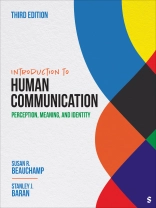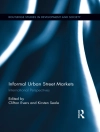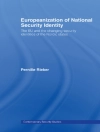Now published by Sage
Introduction to Human Communication, Third Edition, offers a comprehensive and balanced survey of the discipline. Susan R. Beauchamp and Stanley J. Baran show students how central successful communication is to gaining effective control over perception, meaning making, and identity. After walking students through the basics of communication theory and research, they provide tools to help students become more competent, confident, employable, and ethical communicators. A diverse array of real-world examples and practical pedagogical tools help students apply what they′ve learned to a wide variety of communication contexts, including mass and digital communication, media literacy, health communication, interpersonal communication, organizational communication, and intercultural communication.
Daftar Isi
Chapter 1: The Communication Process: Perception, Meaning, and Identity
The Process of Creating Meaning
Culture, Perception, and Schemas
Signs and Symbols
Communication, Perception, Identity . . . and Power
Chapter 2: Communication Research and Inquiry
Theory and Scientific Inquiry
Three Philosophical Questions That Shape Scientific Inquiry
Traditions of Communication Inquiry
Tools of Observation: Research Methods
Chapter 3: Verbal Communication
The Structure of Language
Language and Thought
The Functions of Language
Language and Meaning Making
Language and Protecting Self-Identity
Chapter 4: Nonverbal Communication
What Is Nonverbal Communication?
Theory of Nonverbal Coding Systems
Types of Nonverbal Coding Systems
Nonverbal Coding Errors and Identity
Chapter 5: Listening
What Is Listening?
Misconceptions About Listening
Barriers to Effective Listening
Becoming an Effective Listener
Chapter 6: Relational and Conflict Communication
Interpersonal Communication and Relationship Management
Relational Communication Theories
Interpersonal Communication and Conflict
Chapter 7: Communicating in Small Groups
Small Groups: Types, Dynamics, and Structure
Group Development, Cohesion, and Breakdown
Leadership and Power
Chapter 8: Organizational Communication
Types and Movement of Organizational Messages
Communicating Well in a Bureaucratic System
Organizational Climate and Culture
Chapter 9: Intercultural Communication
What Is Intercultural Communication?
How Cultural Values Shape Communication
The “Naturalness” of Prejudice and Its Antidote
Chapter 10: Mass Communication
What Is Mass Communication?
Culture, Communication, and Mass Media
Characteristics of Media Consumers and Media Industries
Theories of Mass Communication
Chapter 11: Media Literacy
What Is Media Literacy?
Media Literacy Questions
What Does It Mean to Be Media Literate?
Media Literacy Scholarship
Media Literacy and Meaning Making
Chapter 12: Social Media and Personal Communication Technologies
The Double Edge of Changing Communication Technologies
The Dark Side of Social Media and Personal Communication Technologies
How Computer-Mediated Communication Affects Identity
Face-to-Face or Online: The Internet and Interpersonal Communication
Social Media, Loneliness, and Personal Well-Being
Chapter 13: Persuasion and Social Influence
What Is Persuasion?
Values, Attitudes, Beliefs, Behaviors, and Dissonance Theory
What Factors Influence Persuasion?
The Elaboration Likelihood Model of Persuasion
Processes of Attitude Change
Chapter 14: Health Communication
Communication and a Long and Healthy Life
Health Communication in Provider–Client Settings
Health Communication Contexts
Health Communication and the Internet
Chapter 15: Public Speaking: An Overview
The Importance of Public Speaking
Types of Speeches
A Crash Course in Public Speaking
Identifying the Steps of Speech Preparation
Overcoming Public Speaking Anxiety
Tentang Penulis
Stanley J. Baran, Professor Emeritus in the Communication Department at Bryant University, earned his Ph D in communication research at the University of Massachusetts after taking his MA in journalism at Pennsylvania State University. He has taught at Cleveland State University; the University of Texas at Austin, where he won the AMOCO Teaching Excellence Award as the best instructor on that 40, 000-student campus; and at San Jose State University, where he was named President’s Scholar as the university’s outstanding researcher. As a Fulbright Scholar he taught at the Institut fur Journalismus und Kommunication at the Hochschule fur Musik und Theater in Hannover, Germany. Dr. Baran has published ten books and scores of scholarly articles and has sat on the editorial boards of six scholarly journals. His work has been translated into half a dozen languages.












